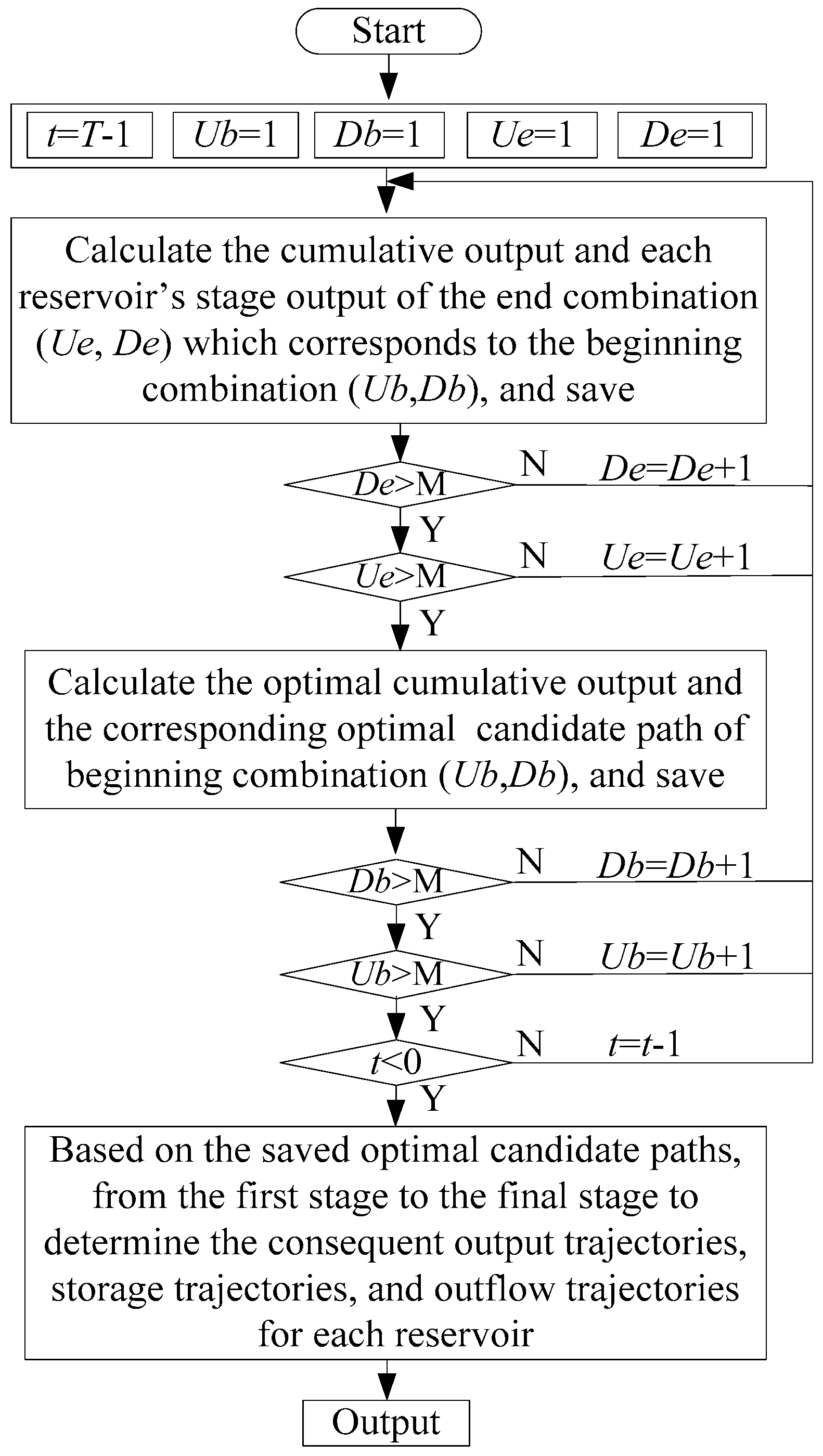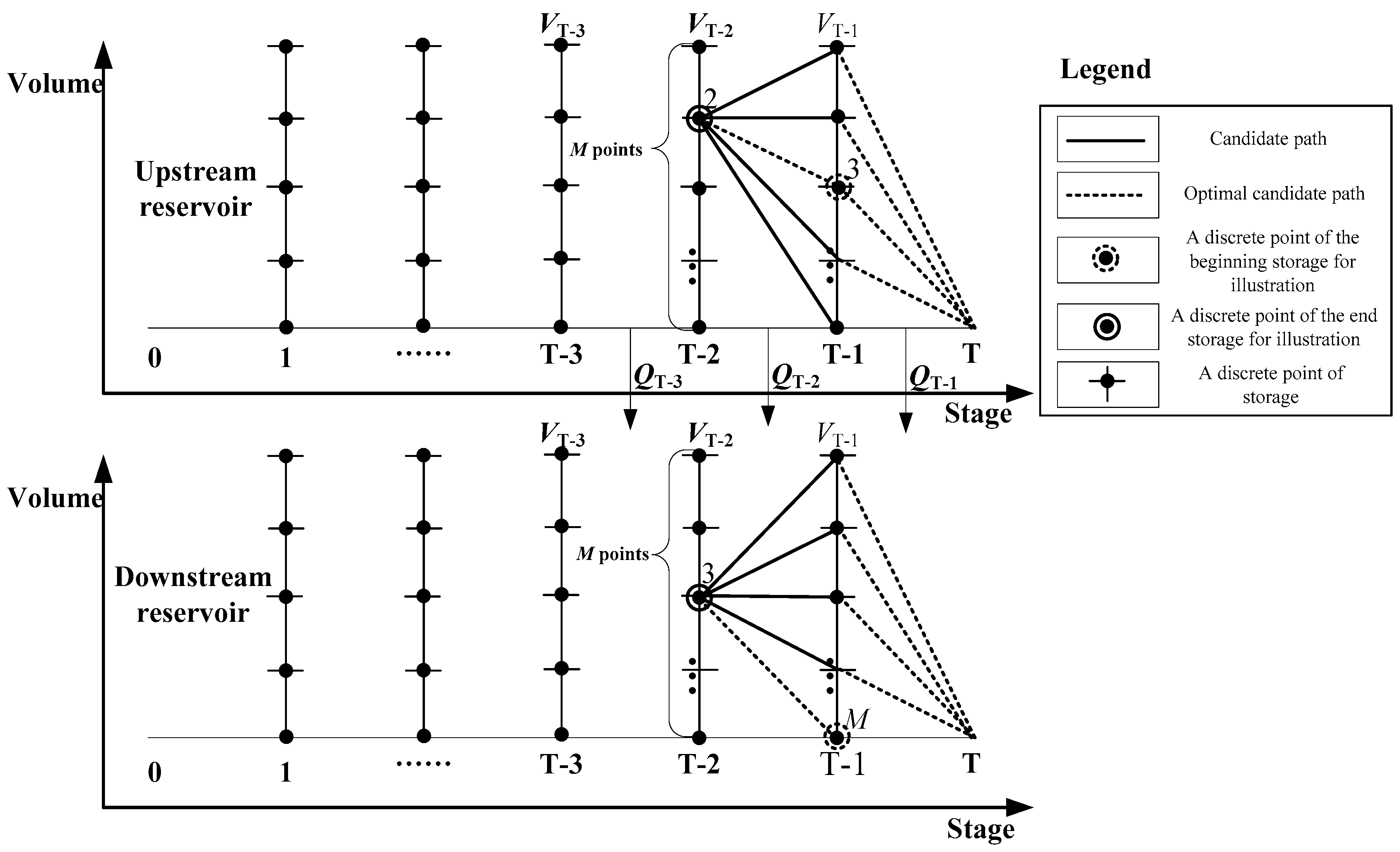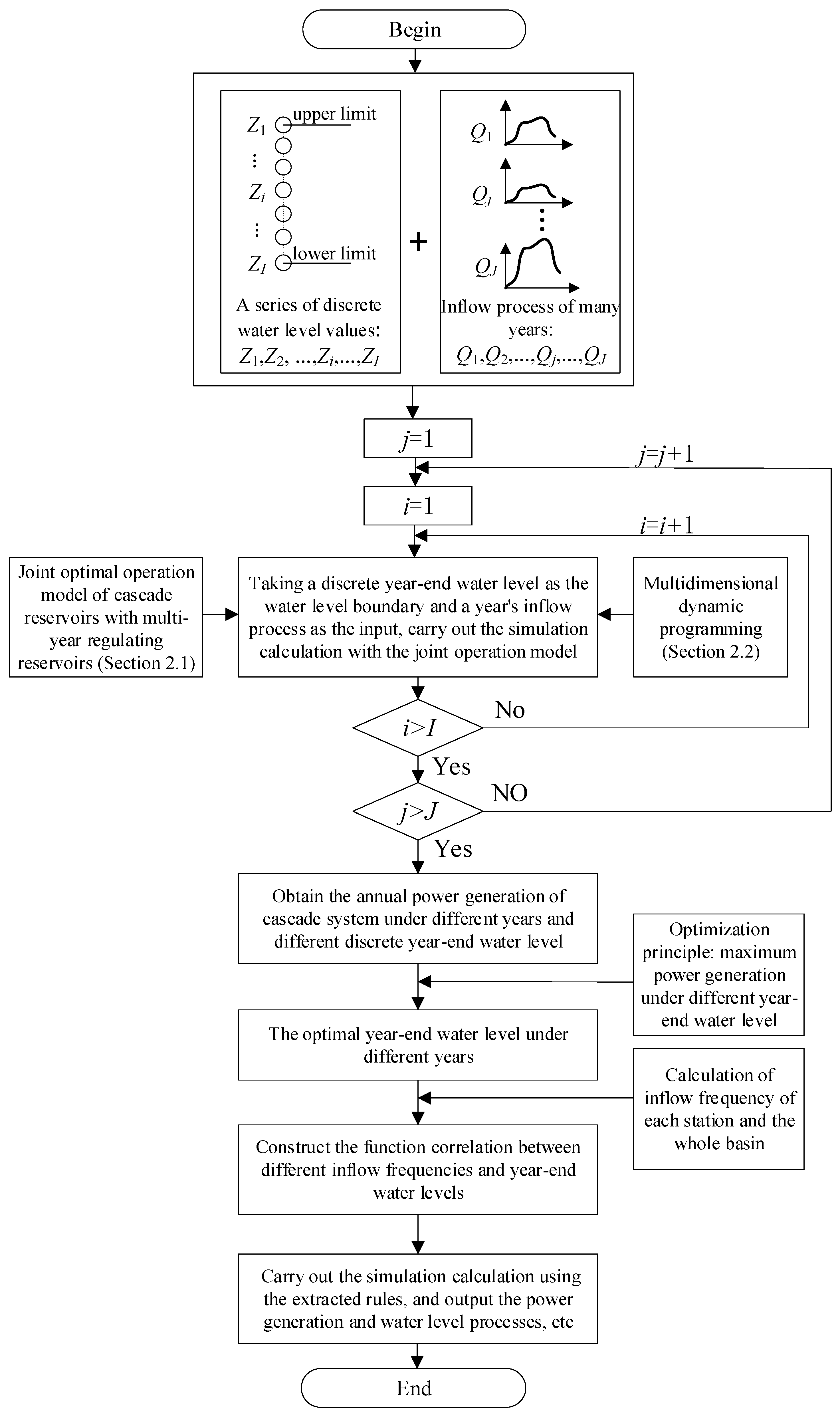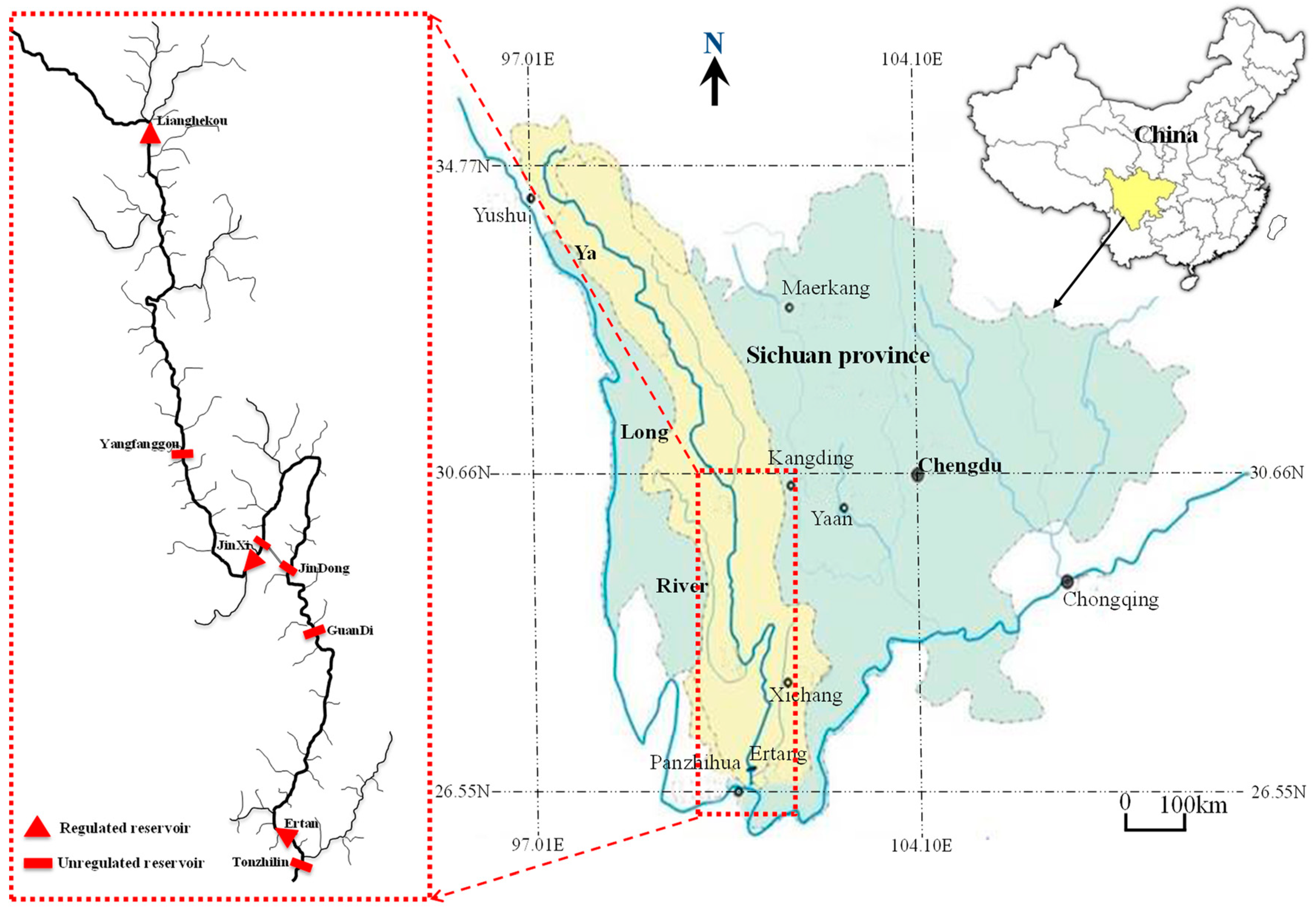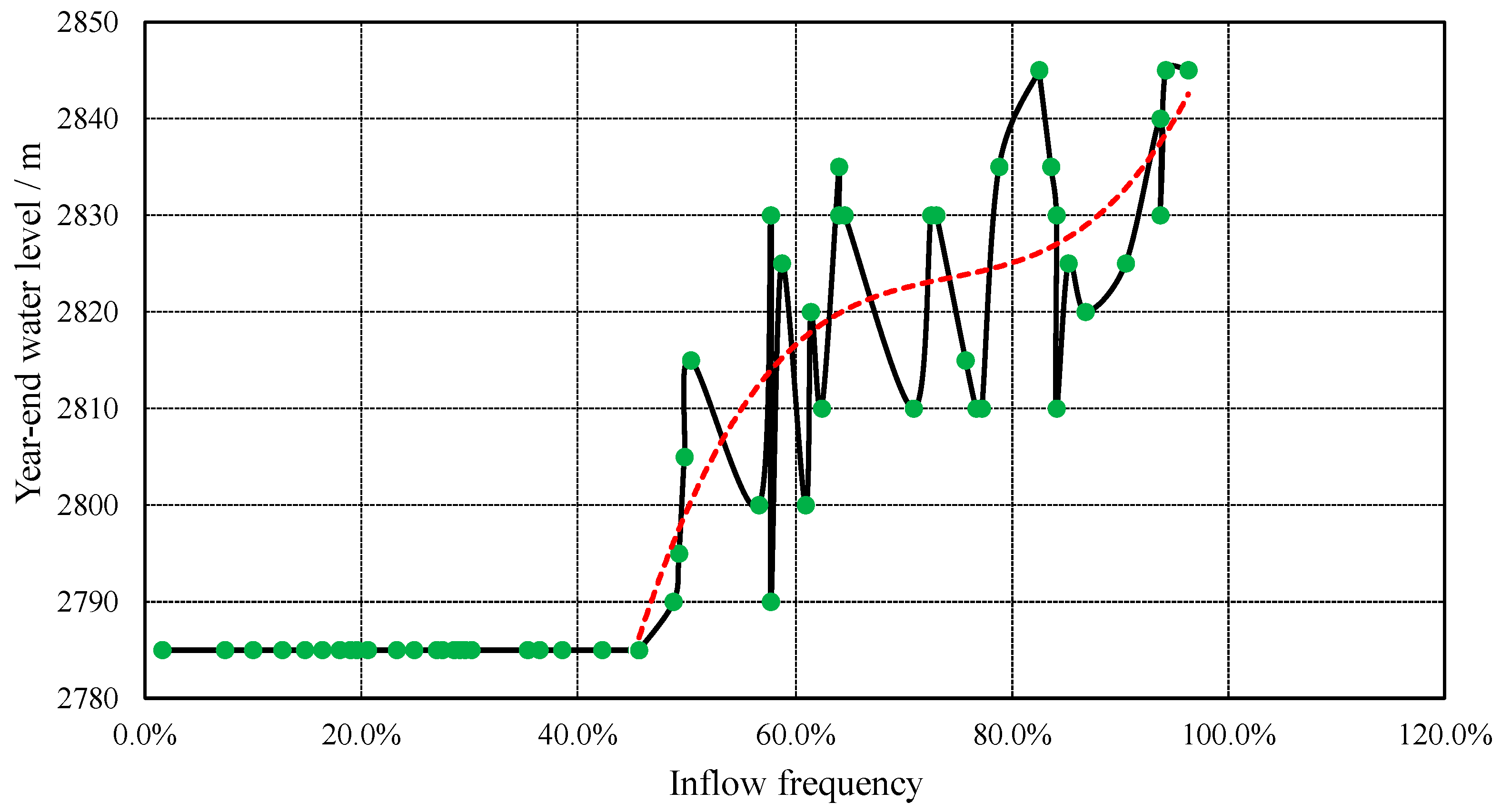3.2. Results and Discussion
In order to analyze the variation of power generation of cascade system under different year-end water levels of Lianghekou reservoir, we take 5 m as the discrete interval, (2785 m–2845 m) as the discrete range, and get different discrete year-end level values, i.e., 2785 m, 2790 m, 2795 m, 2800 m, 2805 m, 2810 m, 2815 m, 2820 m, 2825 m, 2830 m, 2835 m, 2840 m, and 2845 m. Then, these year-end levels are respectively taken as the lower limit constraint of water level in the cascade reservoirs operation optimization model described in
Section 2.1, and the model is solved with the method described in
Section 2.2. Under the multi-year average situation, the total power generations of the cascade system under different discrete year-end water levels of Lianghekou reservoir are shown in
Table 2.
From
Table 2, it can be seen that with the increase of the year-end water level, the annual average power generation of cascade system gradually decreases. When the year-end water level is 2785 m, the annual average power generation of cascade system is the largest. That is to say, under the multi-year average situation, the 2785 m is the best year-end water level, i.e., if the Lianghekou reservoir is operated as an annual regulating reservoir under this situation, the total power generation of the cascade system is the largest.
The annual average power generations in
Table 2 only consider the different year-end water levels, in fact, the power generation is affected not only by the water level, but also by the inflow; that is, the inflow frequency. For a specific year, the maximum annual power generation is the comprehensive result of reservoir water level and inflow process. Therefore, in order to analyze the power generation variations of the cascade system under different inflow conditions and different year-end levels, and discuss the coupling relationship between the year-end water level and inflow frequency on the cascade power generation, we firstly analyzed and compared the results of three kinds of typical years, i.e., wet year, normal year and dry year.
Based on the inflow data of Lianghekou, Jinxi and Ertan stations, we selected five typical years for the analysis from the overall perspective of the basin, as shown in
Table 3. Considering the complexity of dry years, we chose three typical dry years. For the three kind of typical years, the difference is mainly the difference of inflow, which also reflects the difference of rainfall level to a certain extent. For the wet year, the rainfall is rich, so the inflow of the reservoir is large. For the dry year, the rainfall is poor, so the inflow of the reservoir is small. For the normal year, the inflow and rainfall are relatively moderate.
According to the model described in
Section 2.1 and the model solution method described in
Section 2.2, the calculation is carried out based on the runoff data of the wet year, and the results are shown in
Table 4.
From the calculation results of the wet year, it can be seen that with the increase of the year-end water level of Lianghekou reservoir, the total power generation of the cascade system gradually decreases, the power generation of Lianghekou reservoir increases first and then decreases, and the total power generation of the downstream reservoirs gradually decreases.
The power generation of Lianghekou reservoir increases first and then decreases with the increase of year-end water level. The reason is that when the year-end water level H is low, it can be seen that the contribution of H to N is small according to the output calculation formula N = KQH in Equation (1), so the water head benefit of the reservoir is very low. When the year-end water level is high, the water head benefit is large; however, because a large amount of water is used to raise the water head, the discharge flow Q used for power generation is small. So, the contribution of Q to N is small, i.e., the water quantity benefit is small. So, only in a middle position (such as 2805 m), the water quantity benefit and head benefit are both better, and the sum of them reaches the maximum. The water head benefit mentioned above actually refers to the contribution of water head H to the output N, and the water quantity benefit actually refers to the contribution of the discharge flow Q used for power generation to the output N.
The total power generation of the downstream cascade decreases gradually with the increase of the year-end water level. The reason is that the downstream reservoirs can only use the water volume of Lianghekou reservoir and cannot use its water head. Therefore, the lower the year-end water level of Lianghekou reservoir, the greater the amount of water discharged, and the better the power generation of the downstream reservoirs.
The total cascade power generation is the sum of the power generation of Lianghekou reservoir and the power generation of the downstream reservoirs. With the increase of the year-end water level of Lianghekou reservoir, the total power generation of the cascade system gradually decreases. The reason is that in the wet season, the water head of the downstream reservoirs is high, and the sum of the water head is a very large value. At this time, for every cubic meter of water discharged by the Lianghekou reservoir, the downstream reservoirs will get great power generation benefits. Before 2805 m, although the power generation of Lianghekou reservoir increased with the increase of the year-end water level, the water head effect of the downstream reservoirs is remarkable at this time. The increase of the year-end water level means the decrease of the discharge, which will greatly reduce the power generation of the downstream reservoirs, and finally make the overall cascade system presents a decreasing trend. After 2805 m, the power generation of Lianghekou reservoir and the downstream reservoirs both decreases with the increase of the year-end water level, so the total power generation of the cascade system decrease gradually.
In general, in the wet year, when the year-end water level is the dead level, the overall benefit of the cascade system is the best.
According to the model described in
Section 2.1 and the model solution method described in
Section 2.2, the calculation is carried out based on the runoff data of the normal year, and the results are shown in
Table 5.
From the calculation results of the normal year, it can be seen that the variation law of power generation is exactly the same as that of the wet year, except that the year-end water level of Lianghekou reservoir at the turning point of power generation is 2825 m, not the 2805 m of the wet year. In general, the overall benefit of the cascade system is the best when the year-end water level is the dead level in the normal year.
According to the model described in
Section 2.1 and the model solution method described in
Section 2.2, the calculation is carried out based on the runoff data of the three dry years, and the results are shown in
Table 6,
Table 7 and
Table 8.
From the results of the dry year, it can be seen that with the increase of the year-end water level of Lianghekou reservoir, the power generation of Lianghekou reservoir itself increases first and then decreases, which is consistent with the variation law of the wet year and the normal year. However, for the cascade total power generation, its value does not strictly decrease with the increase of the year-end water level, but shows the trend of increasing first and then decreasing. For the power generation of downstream reservoirs, the variation has no regularity compared with the wet year and normal year.
The total power generation of the cascade system increases first and then decreases. The reason is that in the dry year, the water head of the downstream reservoirs is not high enough, and the sum of the water head of the downstream reservoirs is also smaller than that in the wet and normal year, which means that for each cubic meter of water discharged by the Lianghekou reservoir, the downstream reservoirs is not necessarily able to obtain large power generation. At this time, it is more advantageous for the water to be stored in the Lianghekou reservoir to raise its own water head; for example, when the year-end water level is before 2830 m in the second dry year, and when the year-end water level is before 2825 m in the third dry year. However, the Lianghekou reservoir cannot just store water without releasing it (for example, the year-end water level is 2845 m), otherwise the power generation benefit of the downstream reservoirs will be very small. Therefore, there is a compromise year-end water level which makes the sum of the power generation of Lianghekou reservoir and downstream reservoirs reaches the maximum; that is, the total generation benefit of cascade system reaches the maximum.
From the above results analysis, it can be concluded that the results of wet year and normal year have a strong regularity (the dead water level is the best), but the results of dry years are more complex and the regularity is weak, which needs further in-depth analysis. In view of this, in order to analyze the optimal year-end water level of Lianghekou reservoir under different inflow frequencies, and to extract the general rules to guide the actual operation, we calculated all the years based on the 62 years runoff data, and arranged their results by the inflow frequencies with ascending order, as shown in
Table 9. The average multi-year power generation of cascade system is 101.02 billion kWh at this time.
According to the results in
Table 9, the scatter diagram with the inflow frequency as the abscissa and the year-end water level as the ordinate can be obtained, as shown in
Figure 7.
From
Figure 7, it can be seen that in the wet years (inflow frequency below 48.7%), the optimal year-end water level is 2875 m (dead water level). While in the dry years, the optimal year-end water level fluctuates greatly in different years, and the regularity is not strong, but the overall trend is rising. That is to say, in the years with low inflow, the optimal year-end water level basically increases with the increase of inflow frequency.
Considering the practicability of the calculation results, it is necessary to extract the overall regularity of the year-end water level in dry years to guide the actual reservoir operation. For this reason, based on the results data where the inflow frequency greater than 48.7%, we have drawn a scatter diagram and fitted the best trend line based on the least square principle [
24,
25], as shown in
Figure 7.
According to the results in
Figure 7, the best function relationship between the inflow frequency and the year-end water level in the dry years is as follows.
where
Y is the year-end water level and
I is the inflow frequency. The correlation index
R2 corresponding to the above Equation (9) is 0.73.
Therefore, it can be concluded that under different inflow frequencies, the determination rules of the year-end water level of Lianghekou reservoir are as follows.
At this time, according to the Equation (10), the year-end water level under different inflow frequencies can be determined, and then the simulation calculation can be carried out, and the annual power generation can be obtained, as shown in
Table 10 (sorted by inflow frequency with ascending order). The annual average power generation of cascade system is 100.984 billion kWh at this time. It should be noted that since the historical runoff data is used in this paper, the inflow frequency of each year is known at this time. In practical application, the inflow frequency forecasting [
26,
27] should be used to obtain the inflow frequency of future years.
Compared with the results in
Table 9 and
Table 10, the average annual power generation in
Table 9 is 101.02 billion kWh, and that in
Table 10 is 100.984 billion kWh. Although the power generation obtained by simulation operation according to the year-end water level determined by the extracted rules is reduced, the absolute value is 36 million kWh, and the relative reduction is only 0.036%. In addition, it is easy and feasible to operate the reservoir according to the extracted rules.
Compared with the results of multi-year fixed year-end water level in
Table 2, the average annual power generation (100.984 billion kWh) in
Table 10 is higher than the maximum value (100.58 billion kWh) in
Table 2. The difference is 0.404 billion kWh (100.984 billion kWh minus 100.58 billion kWh), representing an increase of 0.4%. Although it seems that the increase of 0.4% is very small; in fact, the base number of annual generation of the cascade system is very large, and this is the annual increment. In the long run, the economic benefit is very significant, which also shows the effectiveness of the method in this paper.
So, it can be seen that the extracted rules of year-end water level under different inflow frequencies not only has strong operability, but also can well coordinate the coupling relationship between the inflow frequency (water volume) and the year-end water level (water head) of Lianghekou reservoir. They can give full play to the overall benefits of the cascade reservoirs system, so that the total power generation of the cascade system by rules is very close to that by the optimal calculation. After obtaining the above extracted rules, the actual reservoir operation can be guided by these rules. Firstly, the annual inflow frequency of the current year can be obtained according to the inflow frequency prediction model, and then the optimal year-end water level of multi-year regulating reservoir can be obtained according to the predicted inflow frequency and Equation (10), and finally, the actual operation can be carried out based on this year-end water level.
